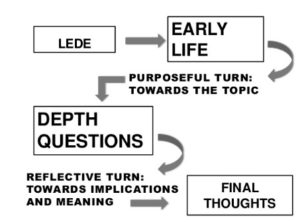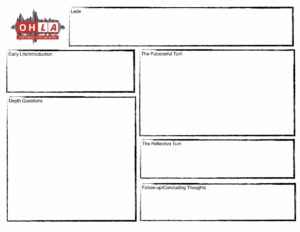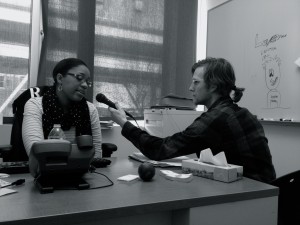[vc_row][vc_column][vc_column_text] As Michael Frisch reminds us in his foundational text Shared Authority, what questions to ask, and what can be known from the responses are “by no means self evident.” In my experience, teaching undergraduates how to conduct good interviews begins with a strong project statement, a good list of ‘depth’ questions, and a sense of how to structure the time space of the interview. In fact, I tell students there are only three ways to become a better interviewer— know your topic (do background research and be able to articulate a project statement and good questions), be a deep listener (ask follow up questions, be engaged, sit close, hold eye contact), and do not allow your interview to go, in phenomenologist Max van Mannen’s words, “everywhere and nowhere” (structure the interview space).
Before We Begin: Some Thoughts on Informed Consent & Best Practices of the Oral History Association
If you’re looking into OHLA resources, you are most likely a faculty member with a particular disciplinary orientation and a course on the books. You’re interested in getting students out of the classroom and into the community with audio recording gear, because you share the vision that community-based learning is an active, participatory, experiential pedagogical strategy for more meaningful learning that ‘sticks’. You’re not teaching an oral history course per se, you are teaching an American literature course that explores themes of migrant farm labor, or you are a math professor attempting to convince a first-year seminar that math will be relevant to their lives, or perhaps you are a historian with an interest in collecting stories about hyper-local themes (be they historical or more contemporary) in your campus community. In other words, you are adept at teaching your topic through your disciplinary lens. You simply need some resources to get your students interviewing as a method of primary source inquiry that will enable them to chase down the themes of your course outside the classroom.
If you’re thinking of employing oral history methodology as a pedagogical strategy for undergraduate research, you’re going to familiarize yourself with the Best Practices of the Oral History Association [1], which distinguishes oral history interviews from other kinds of interviewing because, in a nut shell, the interviewers are well versed in the topic of inquiry and the interviews will be made available to other researchers (in full) by way of shared best practices based upon Informed Consent. If you’re like me, you’ll also check into the earlier Evaluation Guidelines [2], which go a little deeper into the ethical nuances of good practice.
With this under your belt, you’re ready for this post, which provides a pedagogical overview with a project template, a release form template, and a worksheet for helping students determine their questions as they learn to structure the interview space. While one can spend a lifetime exploring and refining these practices, this is a crash-course for undergrads (who will certainly learn as much from the experience of interviewing as they will from the narratives collected).
Project Statement & Release Form
I insist that the work begins with developing a project statement. I frame this as a minimalist (one or two page) statement that describes the project and what it attempts to explore, the intention of the researcher, and how the interview content will be used. Students should conceive of this document as a tool for recruiting interviewees. What does the potential interviewee need to know in order to agree—voluntarily and knowingly— to participate in the project?
- What is this project exploring or documenting? This is your ‘elevator pitch’ or short statement of purpose. No more than a short paragraph! Push for concise descriptions and brevity.
- What is the intention of the researcher? Be honest! If your student is attempting to problematize something through their interviews, this should be clear. It’s imperative for Informed Consent.
- What is the core outcome of the project? In other words, how will the interview content be used and shared to a public audience? The digital age complicates Informed Consent. If the student will be creating a digital project, and/or will have a Facebook page where interviews will be shared out, then it is imperative the student helps potential interviewees to imagine possible audiences.
The project statement template I use is embedded here for your reference. Please feel free to download a copy as an editable doc (project-statement [3]) and make it yours, based upon your institution’s requirements. (Nota bene: Check with your Institutional Review Board to see what requirements they have in place for college-affiliated projects involving identifiable human participants whose ‘data’ will be shared to a public audience beyond the class. While the best practices promoted by the Oral History Association don’t require signed informed consent before the interview, some colleges will require it to meet federal guidelines. Still others completely exempt oral history. If signed informed consent applies to your project at your college, this form has a line for a signature. If not, delete it.)
The most important thing to remember is that the project statement facilitates Informed Consent, but is not, in and of itself, informed consent. In oral history work, getting Informed Consent requires a dialogue that fosters a deep understanding of the project’s goals and the researcher’s intent.
Informed Consent & Copyright are Separate Legal Concepts
In higher ed, we must be careful not to conflate informed consent and copyright. Informed consent can be confusing because the phrase is used in different communities of practice to denote somewhat different things. In oral history, informed consent is the cohesive ethical framework employed by the oral history community that ensures the interviewer makes everything known to the potential interviewee that they would need to know to voluntarily participate— it’s the process that happens before the interview. In fact, Informed Consent is such a comprehensive ethical framework that many have argued to let oral history work proceed completely outside of the bounds of IRB purview.
Researchers from the social sciences tend to use informed consent to denote a document that is signed before the research process begins (whether the research is interview-based or involves any other number of methodologies). If your project falls under the purview of your Institutional Review Board, you’ll probably need to get a signature of informed consent (see the line at the bottom of the form for a signature).
Copyright is a completely different legal concept that is tended to after the interview is complete. By signing a copyright release form, your interviewee allows you to do things with the interview. You can start with a form like this (INTERVIEW-student-release-form [4]) for independent student work. Note that the language on how the interviews will be shared and published should match on the project statement and release form.
Remember, the digital age complicates informed consent. Help your students be thoughtful about the potential audiences for their interviewee’s narratives. Don’t allow student researchers to promise restrictions to access that can’t be maintained in the digital era.
Outreach
Community Partnerships [5] are important in oral history work. If you’re a faculty member, you can approach the logistics of fostering these connections in two ways. Independent student researchers who have chosen their own themes can do their own planning and outreach, but we as faculty should be mindful that our undergraduates do not always have high standards of professional communication by email and by phone. An email entry that starts with “Hey” probably isn’t representing the project and its intent in the best light. But where’s the balance between youthful and being a good communicator or project ambassador?
Long term projects devised by faculty that will engage students across multiple terms should be managed, largely, by the faculty member who is the first point of contact. I’m a firm believer that the implicit skills gained by students doing this work are often as important as the themes of the collection. (More on that later in the pedagogy section.)
The Abbreviated Life Story Interview Model

Brooke’s Abbreviated Life Story Model can help students structure the interview space. Below are resources to help interviewers plan, leading the dialogue through 6 key phases, beginning with the lede (which establishes informed consent), conversation on early life (which provides meaningful interpretive context for the speaker and allows for rapport development), a purposeful turn toward the topic, the depth questions which frame the core of the inquiry and provide similarity across interviews, the reflective turn which brings out the implications, and final thoughts that gives the narrator an opportunity to talk about things not asked about.
Through years of teaching and learning a replicable interview strategy, I’ve amalgamated this turn-key tactical approach to structuring the interview space that students tend to find very helpful.
Beginning interviewers:
- tend to turn on the recording gear, and jump straight into a heady, abstract question that leaves the interviewee blinking in the headlights
- are preoccupied with a litany of questions
- often talk over the speaker, from ‘ums’ and ‘oh’s’ to stories of personal relation to the concept
- fail to allow for pause and open reflection (filling uncomfortable silence with chatter)
- are really nervous!
I firmly believe that there are only three ways to be a good interviewer:
- know your topic (do background research and be able to articulate a project statement and a small, core set of good questions)
- be a deep listener (ask follow up questions, be engaged, sit close, hold eye contact, remember that gestures can speak louder than words)
- structure the interview space (do not allow your interview to go, in phenomenologist Max van Mannen’s words, “everywhere and nowhere” by being in thoughtful dialogue and causing a few key ‘turns’ in the interview)

The Abbreviated Life Story Model is just one way to think about structuring the interview space. Developed over years of teaching undergraduates, volunteers, and secondary students to interview, it’s amalgamated from many sources, methods, and trends. I’ve found it particularly helpful when working with people who have little formal methodological training. It asks interviewers to come to the interview with a prescribed lede, a number of ‘depth questions’, and a sensibility of helping the interview through a couple key turns to ensure it is both a dialogue and a meaningful exploration of the themes at hand.
The 17 page power point below will walk you through the planning model, and the worksheet above may help you or your students brainstorm questions to lead the interview through the necessary stages. Do you have a model for structuring the interview space?
[/vc_column_text][/vc_column][/vc_row]
